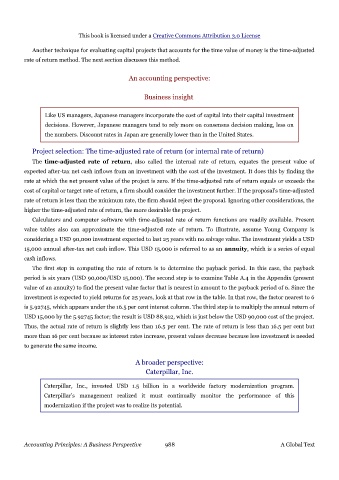Page 987 - Accounting Principles (A Business Perspective)
P. 987
This book is licensed under a Creative Commons Attribution 3.0 License
Another technique for evaluating capital projects that accounts for the time value of money is the time-adjusted
rate of return method. The next section discusses this method.
An accounting perspective:
Business insight
Like US managers, Japanese managers incorporate the cost of capital into their capital investment
decisions. However, Japanese managers tend to rely more on consensus decision making, less on
the numbers. Discount rates in Japan are generally lower than in the United States.
Project selection: The time-adjusted rate of return (or internal rate of return)
The time-adjusted rate of return, also called the internal rate of return, equates the present value of
expected after-tax net cash inflows from an investment with the cost of the investment. It does this by finding the
rate at which the net present value of the project is zero. If the time-adjusted rate of return equals or exceeds the
cost of capital or target rate of return, a firm should consider the investment further. If the proposal's time-adjusted
rate of return is less than the minimum rate, the firm should reject the proposal. Ignoring other considerations, the
higher the time-adjusted rate of return, the more desirable the project.
Calculators and computer software with time-adjusted rate of return functions are readily available. Present
value tables also can approximate the time-adjusted rate of return. To illustrate, assume Young Company is
considering a USD 90,000 investment expected to last 25 years with no salvage value. The investment yields a USD
15,000 annual after-tax net cash inflow. This USD 15,000 is referred to as an annuity, which is a series of equal
cash inflows.
The first step in computing the rate of return is to determine the payback period. In this case, the payback
period is six years (USD 90,000/USD 15,000). The second step is to examine Table A.4 in the Appendix (present
value of an annuity) to find the present value factor that is nearest in amount to the payback period of 6. Since the
investment is expected to yield returns for 25 years, look at that row in the table. In that row, the factor nearest to 6
is 5.92745, which appears under the 16.5 per cent interest column. The third step is to multiply the annual return of
USD 15,000 by the 5.92745 factor; the result is USD 88,912, which is just below the USD 90,000 cost of the project.
Thus, the actual rate of return is slightly less than 16.5 per cent. The rate of return is less than 16.5 per cent but
more than 16 per cent because as interest rates increase, present values decrease because less investment is needed
to generate the same income.
A broader perspective:
Caterpillar, Inc.
Caterpillar, Inc., invested USD 1.5 billion in a worldwide factory modernization program.
Caterpillar's management realized it must continually monitor the performance of this
modernization if the project was to realize its potential.
Accounting Principles: A Business Perspective 988 A Global Text

